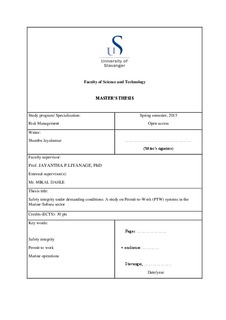| dc.description.abstract | Last few years has seen evaluation of the oil and gas industry into innovative subsea solution and technological leap leading to the subsea factory. Taking this into perspective the marine subsea industry is one of the most developing sectors involving many stakeholders with a wide range of background to perform various operations. These operations bring together marine operators, ship owners, subsea asset owners/asset operators, subsea equipment manufacturers, various subcontractors, yards, etc., to work together under demanding conditions. Due to high-risk nature of oil & gas business, such operations constitute various critical features requiring specific measures to reduce unwanted events and risk exposure. The permit to work (PTW) system is such a critical measure, which is an integral part of a safe working structure that can help to manage the wide range of activities taking place simultaneously. Risk assessment and risk mitigation, which are core elements for the PTW system, are key contributors for safe execution of jobs. A comprehensive PTW system should not only determine how the work can be carried out safely but also should envisage human factors involved in operations.
In addition to generic features that are relevant to normal PTW systems, there are specific needs to account for the nuances of the marine subsea industry. This is to increase the safety as well as efficiency of operations especially under demanding conditions in terms of time, cost, and safety. Years of experiences have begun to question if PTW systems should be applied to all activities since current practices have a considerable potential to lead to many confusions among stakeholders weakening the overall effectiveness. This would require a closer analysis of the current PTW systems and practices to ensure safety integrity as well as to establish an effective work interface between stakeholders.
This thesis assesses the state of current PTW system in the marine subsea industry and present the lesson learnt from previous projects and suggest best practices and potential improvements for a seamless interface and expectations. | nb_NO |
